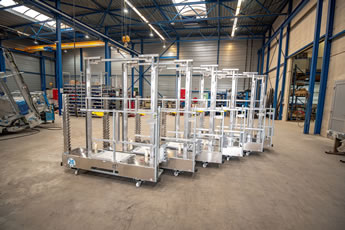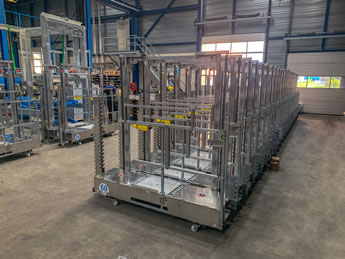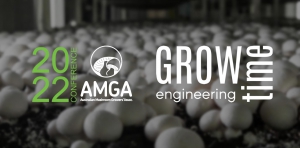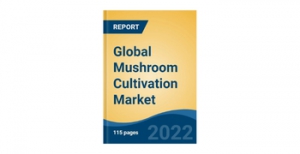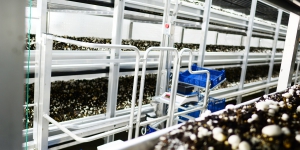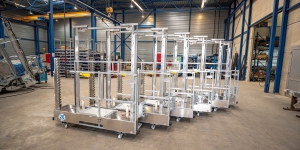
Mushroom Matter
Welcome on our platform. Why MUSHROOM MATTER? Because mushrooms play an important role in our lives as well in business. Our goal is to bring the world the very latest mushroom news with the upmost care to support the positioning of our beloved Mushroom.
AMGA 2022 Conference
The AMGA conference is held every two years and is the principal meeting point for professionals involved in the mushroom growing industry in Australasia and welcomes numerous guests from overseas.
The conference is made up of suppliers, growers, farm owners and well respected national and international speakers. It’s the perfect occasion to gain pragmatic advice from the speakers, connect with other professionals through genuine networking opportunities, and to increase your knowledge of the industry.
One of our appreciated advertisers, GROWTIME, is also present on this conference with a stand. Please find their invitation here below:
Visit us at the 44th Australian Mushroom Growers' Conference
Are you part of the mushroom industry? You are invited to the 44th Australian Mushroom Growers’ Conference, which will be held from October 26 to 28 at the Crowne Plaza Adelaide Hotel. Come up to us and let's talk about the profitability of your mushroom farm!
Where can you find us? Below you will see our location on the floor plan of the event. See you there!

The energy-intensive production of edible mushrooms is currently particularly affected by the impact of the Ukraine war on the procurement of electricity and gas for food production. This became clear once again at an extraordinary meeting of the Board and Advisory Council of the Federation of German Mushroom and Cultivated Mushroom Growers (BDC) on 6 September 2022 in Hanover.
During the intensive exchange with representatives of the Federal Association of Energy Users (VEA), climate control in the cultivation rooms and cooling of the harvested products, but also substrate production as well as hygienisation of the substrate and disinfection of the rooms were named as extremely energy-intensive processes.
Despite this, mushroom farms have so far not been able to participate in the energy cost reduction programme of the Federal Office of Economics and Export Control (BAFA), as they do not belong to the listed sectors. Given the amount of energy required in the cultivated mushroom sector, this is absolutely incomprehensible for the BDC representatives. The board estimates that the electricity and gas price increases alone could generate additional costs of more than 75 million euros for the industry, should the prices for electricity and gas remain at this level or even rise further. Translated with www.DeepL.com/Translator (free version).
Please read the full article here. (in German)
Source: Bund Deutscher Champignon- und Kulturpilzanbauer e.V.
The global mushroom cultivation market is expected to grow at a steady rate in the forecast period, 2023-2027. Factors such as growing per capita mushroom consumption and the rise in awareness about the multiple benefits of mushroom consumption are driving the market growth. Surge in demand for vegan and natural food in the diet and increasing health-consciousness among consumers are the prominent factors expected to accelerate the demand for the global mushroom cultivation market.
Also, rise in the efforts by the market players to adopt the latest technologies will boost the commercial production of mushrooms, which is expected to create numerous growth opportunities for the market players in the global mushroom cultivation market during the forecast period.
Global mushroom cultivation is segmented based on type, raw material, phase, form, application, region, and company. Based on regional analysis, Asia-Pacific is expected to hold a significant market share for the next five years, 2023-2027. China is the largest producer and consumer of mushrooms across the world . An increase in the cultivation of mushrooms along with the increasing consumption in the region are expected to fuel the demand for mushrooms in the country. Also, the adoption of the latest technology for mushroom cultivation by the market players is expected to create numerous growth opportunities for the growth of the global mushroom cultivation market in the forecast period.
Major players operating in the mushroom cultivation market are Smithy Mushrooms Ltd., Rheinische Pilz Zentrale GmbH, Monaghan Mushrooms Ltd, Walsh Mushrooms Group, South Mill Mushrooms Sales Inc., Hirano Mushroom LLC, Gourmet Mushrooms, Inc., Fresh Mushroom Europe NV, L F Lambert Spawn Co, Polar Shiitake Oy, and others.
Please read the full article here.
Source: Research And Markets
A mushroom spawn lab, and orchid micro-propagation lab were inaugurated at Serbithang, Thimphu on September 24. Agriculture Minister Yeshey Penjor and Minister Counsellor, Head of Cooperation, European Union Daniel Hachez inaugurated the facilities.
The new lab will develop pure cultures, develop mother culture, produce and supply mother spawn-to-spawn production unit at the National Mushroom Centre (NMC), regional units, and private spawn producers, produce and supply cultivation spawn with a focus on sawdust spawn for shiitake mushroom cultivation and conduct research and trials; and variety release, among others.
NMC Program Director Dawa Penjor said that the facility will go a long way in improving services to mushroom growers and encouraging new mushroom growers to make Bhutan self-sufficient in mushroom production.
“With the organic brand, we are hopeful to find niche markets in countries like India and Thailand,” he said.
Dawa Penjor said that NMC has a variety of seeds but most farmers are more familiar with two kinds, which are normally planted on wood or in soil. “Farmers are more accustomed to planting these seeds as they know more about its production process and it is mostly what people buy,” he said.
Please read the full article here.
Source: Kuensel
Company in the spotlight PG Kusters
Company visit Thursday 29 September Dreumel the Netherlands
Dreumel, a small village in the land of Maas and Waal in the province Gelderland, The Netherlands. Beautifully situated on the river Waal, surrounded by beautiful dykes and vast fields with many livestock and fruit crops. On one of these dykes the company PG Kusters BV is situated. A real family business with 54 years of Kusters family history. Piet and An Kusters became the Philips- Duphar dealership in 1968 with a product portfolio for fruit cultivation.
Over the years, Piet and An steadily developed their business and got to know other markets, including livestock farming and mushroom cultivation. Children John and Silvia are currently running this family business. They continue to build on the solid foundation laid by their parents. The company is strongly characterised by its level-headedness, modesty, honesty, transparency and loyalty. Several employees have been with them for a long time; Martien van Lieshout has been active within the livestock branch for 41 years. Geert Brink ran the mushroom department in the beginning and handed over the baton to Pascal van Schijndel quite a few years ago.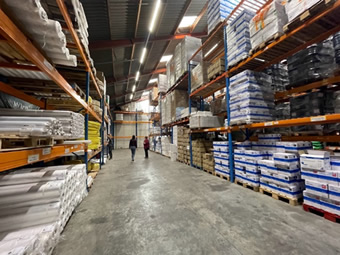
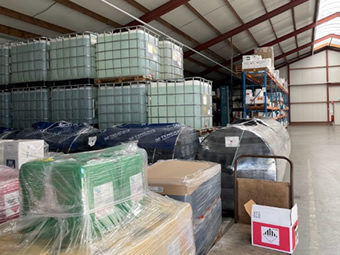
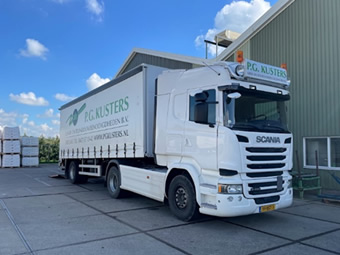
Pascal has been active in the mushroom industry for 30 years, of which 20 at PG Kusters BV. "The great thing about our company is that we have short lines of communication, half a word is enough, so we can switch quickly and provide the customer with their products very rapidly". We are always reachable, a lot is possible with us and we solve everything". PG Kusters BV supplies various products to mushroom growers such as slide nets, tunnel cloths, growing mats, foils, pesticides, clothing, cleaning agents and disinfectants. Through years of experience and knowledge within this branch, they have built up a nice loyal customer base. 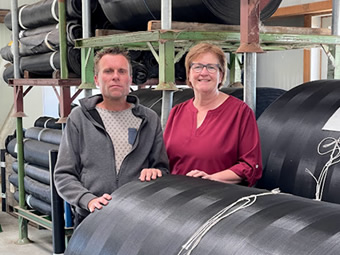 Owner Silvia: "Our focus is on quality, we are experiencing a calm and healthy growth that we can facilitate with our team. We keep both feet on the ground and make sure we continue organising everything with the right attention and focus. From product to delivery, we have everything in-house. The biggest sales market is the Netherlands, this is where our roots, passion and most of our knowledge lie." Nursery mats and slide nets are runners-up within the company; as an official dealer of Ten Cate Geo, PG Kusters BV handles the procurement, supply and repair of these mats.
Owner Silvia: "Our focus is on quality, we are experiencing a calm and healthy growth that we can facilitate with our team. We keep both feet on the ground and make sure we continue organising everything with the right attention and focus. From product to delivery, we have everything in-house. The biggest sales market is the Netherlands, this is where our roots, passion and most of our knowledge lie." Nursery mats and slide nets are runners-up within the company; as an official dealer of Ten Cate Geo, PG Kusters BV handles the procurement, supply and repair of these mats.
Contact details Pascal van Schijndel:
P.G. Kusters B.V., Waaldijk 3, 6621 KG Dreumel
T: (0487) 57 13 42
M: (0651) 64 07 48
This email address is being protected from spambots. You need JavaScript enabled to view it.
When choosing a mushroom picking trolley, it is worth paying attention to those elements of its construction that will affect the comprehensive picking of mushrooms from each shelf of the shelving.
Including the bottom and top shelves of the shelving, access to which is usually a bit more difficult due to their location. So what is worth paying attention to when choosing a trolley?
One comprehensive trolley or an additional one?
As producers of mushroom farm equipment, we often encounter a situation where two types of mushroom picking trolleys work in parallel in a mushroom farm:
● one, used for picking starting from the second / third shelf to the last shelf of the shelving
● second, the low one, used only for picking from the bottom shelf.
Comprehensive trolleys, i.e. those that can easily handle picking from the entire height of the shelving, have an advantage for several reasons:
● along the entire length of the shelving, it is much easier to move with one trolley than to struggle with the necessity of avoiding and maneuvering two trolleys
● trolleys are devices that need to be serviced, and it is less time-consuming and more profitable to service one device than two, and it saves space when it is necessary to move them out
● however, work time savings, people's efficiency and ergonomics are crucial: naturally, with a good picking organization, we will need fewer people to pick in a given time (comprehensive trolley).
Ergonomics, ergonomics and ergonomics once again...
Before choosing the right mushroom picking trolley, it is worth comparing the physical qualities of the trolley, including:
● appropriate construction and location of the seat so that the physical work of the picker is as little tiring as possible
● distance from scales, containers and remote control / control panel so that the number of unnecessary movements is limited to the maximum
● lighting on the trolley mounted in a way that allows good lighting of each shelf of the shelving, both in a sitting and standing position
● the possibility of adjusting individual structural elements of the trolley, among others for people of different heights.
Minimum height of platform lowering / lifting
It is worth paying attention to the maximum and minimum height of the trolley:
● some of the trolleys available on the market do not allow the platform to be lowered to such a low height that picking mushrooms from the bottom shelf is actually efficient or physically possible at all, and not in name only.
● there are also trolleys whose maximum platform height is not sufficient in relation to the height of the shelving, especially when the picker is rather short.
Summary
From our experience, the key factor in choosing a mushroom farm trolley should be aspects related to the ergonomics and construction of the trolley - so as to enable comprehensive and efficient picking from the entire height of the shelving (including the bottom and top shelves).
The best solutions are usually more expensive than the underdeveloped counterparts of other suppliers, but in the long term, they will provide much higher profitability, and real return on investment (low maintenance costs), because the key cost of the mushroom farm is people's work, and thanks to the right solutions we can ensure they are less fatigued and, consequently, more productive, leading to higher profitability of the mushroom farm.
About the author:
GROWTIME is an international manufacturer of mushroom growing farm equipment.
GROWTIME specializes in the production of mushroom picking trolleys, with the focus on increasing the harvesting efficiency thanks to the solutions used in them. See the company's offer at growtime.eu.
A Picking Lorry that is not produced for a grower, but with a grower?
That is correct! This Picking Lorry is developed together with a Dutch grower who had one simple wish:
"Make me a Picking Lorry which is worker friendly too."
The pickers stand as close as possible to the shelving and can reach all heights through automatic
The Compact+ Picking Lorry is designed so that it fits through all working doors, which means no dismantling of the platform or tipping of the frame.
Recently we delivered 60 pieces Compact+ picking lorries to Geurts Champignons in Millheeze, 20 pieces to Agarica in Hoogeveen and 8 pieces to AK Champignons in Hoenzadriel. All those orders are the second batch they ordered because of the good results from the first batch.
The big benefit of those Compact+ picking lorries are that the picker can handle this lorry by herself completely. No help needed from a second person to transfer the lorry to another room. Further they are almost maintenance free and the battery will last for more than two weeks.
Do you want to know more about the picking lorries? See here! 